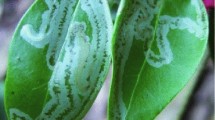Summary
An adaptive significance of linear leaf mining patterns as the anti-parasitoid strategy is theoretically analysed. In the model, a leaf-miner is allowed to move in one of four ways; mining ahead in unexploited area of a leaf, backtracking, branching off from the backtracking mine, and crossing the previous mine. The model parasitoid searches for the leaf-miner by tracing the mine by the tactile cue of mine surface after detecting the mine. The average duration from detecting the mine to finding the leaf-miner host is calculated for various patterns of mining, changing numbers of branches and of crosses. This average duration becomes longer when the leaf-miner stays near either end of the mine compared with when staying near its center. It is also prolonged as the numbers of branches and of crosses increase.
Similar content being viewed by others
References
Askew, R. R. (1968) A survey of leaf-miners and their parasites onLaburnum.Trans. R. Ent. Soc. London 120: 1–37.
Askew, R. R. (1975) The organisation of chalcid-dominated parasitoid communities centered upon endophytic hosts. 130–153. InP. W. Price (ed)Evolutionary strategies of parsitic insects and mites. Plenum, New York.
Askew, R. R. andM. R. Shaw (1979) Mortality factors affecting the leaf-mining stage stages ofPhyllonorycter (Lepidoptera: Gracilariidae) on oak and birch. 1. Analysis of the mortality factors.Zool. J. Linn. Soc. 67: 31–49.
Cameron, F. (1939) The holly leaf-miner (Phytomyza ilicis Curt.) and its parasites.Bull. Ent. Res. 30: 173–208.
Hering, E. M. (1951) Biology of the leafminers.Uitgeverij Dr. W. Junk. Hague.
Katô, M. (1984) Mining pattern of the honeysuckle leaf-minerPhytomyza lonicerae.Res. Popul. Ecol. 26: 84–96.
Papentin, F. (1973) A Darwinian evolutionary system. III. Experiments on the evolution of feeding patterns.J. Theor. Biol. 39: 431–445.
Price, P. W. (1975) Reproductive strategies of parasitoids. 87–111. InP. W. Price (ed)Evolutionary stategies of parasitic insects and mites. Plenum, New York.
Raup, D. M. andA. Seilacher (1969) Fossil foraging behavior: Computer simulation.Science 166 994–995.
Richerson, J. V. andJ. H. Borden (1972) Host finding behaviour ofCoeioides brunneri (Hymenoptera:Braconidae).Canad. Entomol. 104: 1235–1250.
Sugimoto, T. (1977) Ecological studies on the relationship between theRanunzulus leaf-mining fly,Phytomyza ranunculi Schrank (Diptera: Agromyzidae) and its parasiteKratochivilina sp. (Hymenoptera: Eulophidae) from the viewpoint of spatial structure. 1. Analysis of searching and attacking behaviours of the parasite.Appl. Ent. Zool. 12: 87–103.
Takada, H. andK. Kamijo (1979) Parasite complex of the garden pea leaf-minerPhytomyza horticola Gourea, in Japan.Kontyû 47: 18–37.
Vinson, S. B. (1976) Host selection by insect parasitoids.Ann. Rev. Entomol. 21: 109–133.
Author information
Authors and Affiliations
Rights and permissions
About this article
Cite this article
Katô, M. The adaptive significance of leaf-mining pattern as an anti-parasitoid strategy: A theoretical study. Res Popul Ecol 27, 265–275 (1985). https://doi.org/10.1007/BF02515465
Issue Date:
DOI: https://doi.org/10.1007/BF02515465




